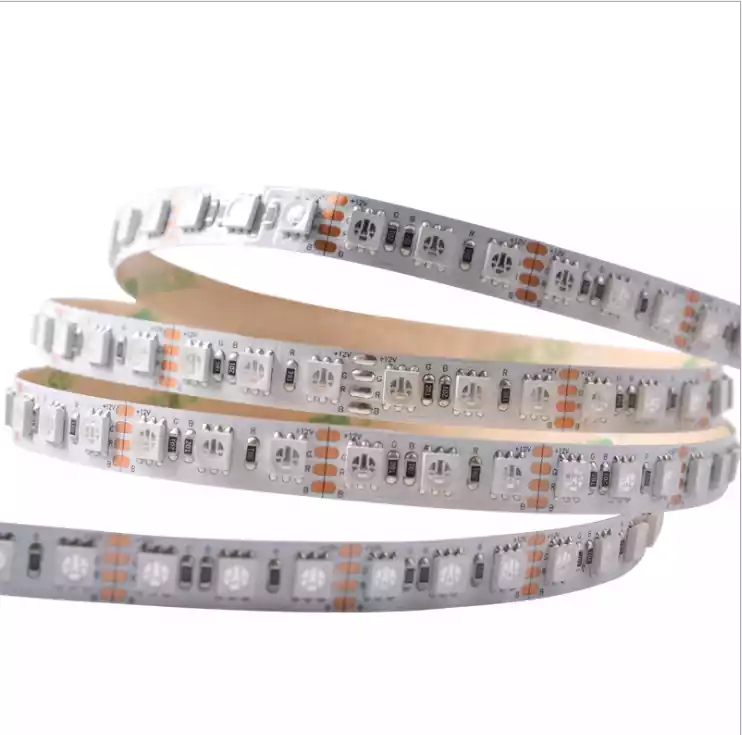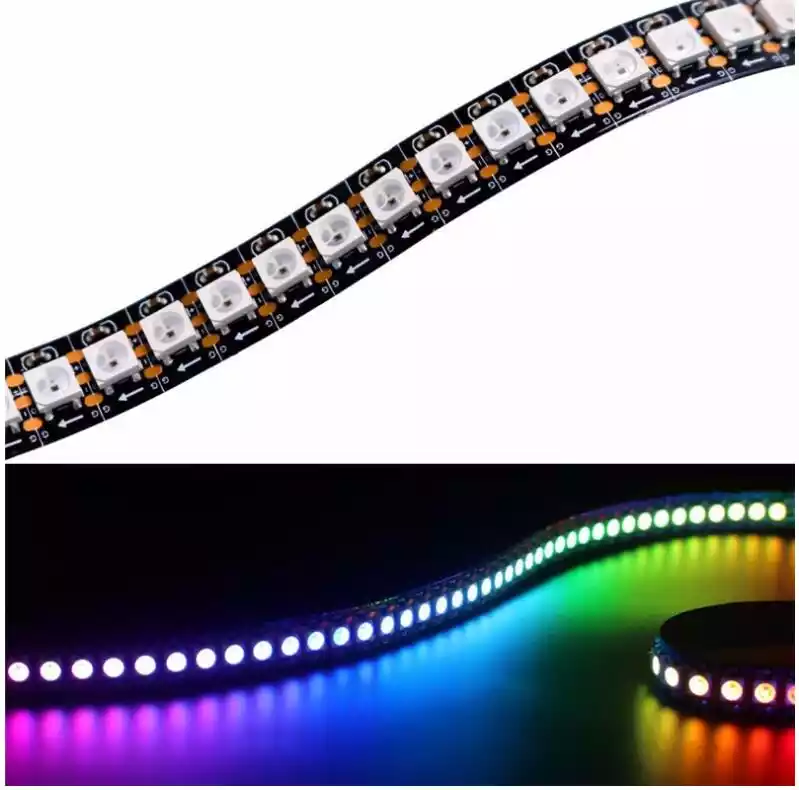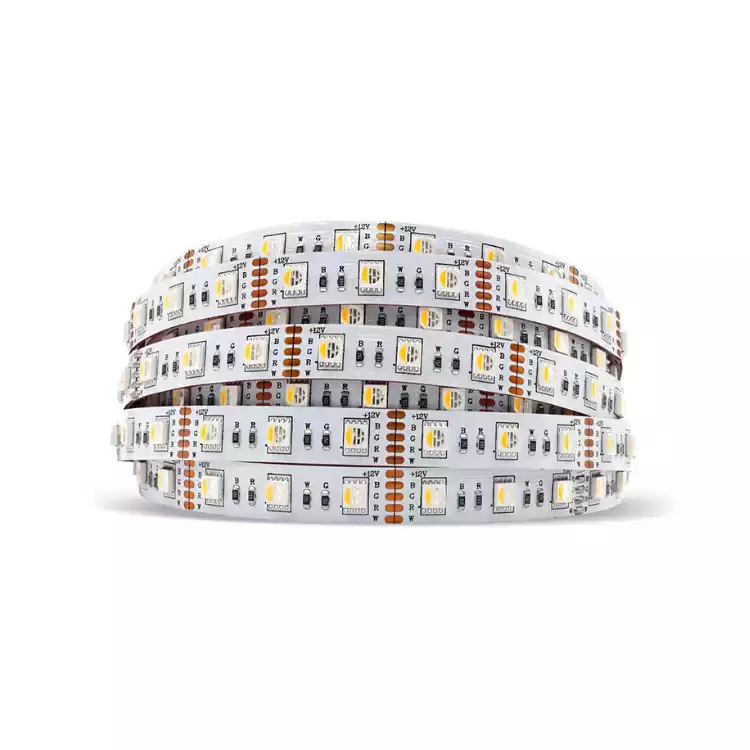RGB vs. RGBW vs. RGBIC vs. RGBWW vs. RGBCCT LED Strip Lights
-
by Maisie Ou
- Last updated February 28, 2023
Table of Contents
When it comes to LED strip lights, there are several options available in the market, including RGB, RGBW, RGBIC, RGBWW, and RGBCCT.
Each of these options has its own unique features and advantages. Let’s take a closer look at each of these types of LED strip lights.
In this article, we will compare and discuss the differences between these types of LED strip lights to help you make an informed decision.
What is LED Strip Light?
LED strip lights, also known as LED tape lights, are flexible circuit boards populated with light-emitting diodes (LEDs) that can produce various colors of light.
They are a popular lighting solution for both residential and commercial applications, including home decor, architectural lighting, and retail displays.
What Do The Below Letters Mean In LED Strips?
There are different types of LED strip lights, and each type is identified by a combination of letters that represent the color and features of the LED strip.
Here are some of the most common letters used in LED strips:
R: Red
G: Green
B: Blue
W: White
WW: Warm White
IC: Individually Controllable
CCT: Correlated Color Temperature
What is RGB LED Strip Light?
RGB LED strip lights are made up of red, green, and blue LEDs that can be mixed together to produce a wide range of colors.
They are popular for adding color and ambiance to rooms, outdoor spaces, and events.
What is RGB LED Strip Light?

RGB stands for red, green, and blue. RGB LED strips contain individual LEDs that emit red, green, and blue light.
By combining different levels of these colors, RGB strips can create a wide range of colors, including white light.
RGB LED strips are the most common type of LED strip and are often used for accent lighting, backlighting, and decorative purposes.
They are ideal for creating dynamic lighting effects and adding a pop of color to any space.
What is RGBW LED Strip Light?
RGBW LED strip lights are similar to RGB LED strip lights, but they also include a separate white LED for producing pure white light. This provides greater flexibility in terms of the colors that can be produced and allows for pure white light to be used when needed.
What is RGBIC LED Strip Light?

RGBIC LED strip lights, also known as addressable LED strips, have each LED chip individually controllable, which means that each LED can produce a different color independently from the others.
This type of LED strip is ideal for creating dynamic and colorful lighting effects.
For more information, you can read The Ultimate Guide To Addressable LED Strip.
What is RGBWW LED Strip Light?

RGBWW LED strip lights include RGB LEDs as well as warm white LEDs, which provide a more natural and warm lighting effect.
This type of LED strip is ideal for applications where a combination of dynamic and warm lighting is desired.
What is RGBCCT LED Strip Light?

RGBCCT LED strip lights include RGB LEDs, warm white LEDs, and cool white LEDs, which can be controlled separately to create a wide range of colors and color temperatures.
This type of LED strip is ideal for applications where both dynamic and natural lighting effects are desired.
RGB Vs. RGBW
RGB LED strips can produce a wide range of colors, but they cannot produce pure white light.
RGBW LED strips, on the other hand, can produce pure white light in addition to a wide range of colors.
This makes RGBW LED strips more versatile than RGB LED strips.
RGBW Vs. RGBWW
RGBW LED strips include both RGB LEDs and a separate white LED, while RGBWW LED strips include both RGB LEDs and warm white LEDs.
The main difference is the color temperature of the white light produced.
RGBW LED strips produce a pure white light, while RGBWW LED strips produce a warm, natural-looking white light.
RGB Vs. RGBIC
RGB LED strips produce a wide range of colors, but the color of each LED cannot be controlled individually.
RGBIC LED strips, on the other hand, have each LED chip individually controllable, which allows for more dynamic and complex lighting effects.
RGB vs. RGBW vs. RGBIC vs. RGBWW vs. RGBCCT LED Strip Lights
Each type of LED strip light has its own unique features and advantages.
| LED Strip Type | RGB | RGBW | RGBIC | RGBWW | RGBCCT |
| Color Options | 16 million | 16 million | 16 million | Warm white and cool white | 16 million, plus adjustable white |
| LEDs per Chip | 3 | 4 | 3 + build-in IC | 5 | 5 |
| Color Control | Individual color control | Individual color control | Individually addressable LEDs | Individual color control plus separate warm white and cool white | Individual color control plus adjustable white |
| White Color Temperature | Not applicable | Not applicable | Not applicable | 2700K – 6500K | Adjustable white |
| Application | Ambience lighting, mood lighting, decoration | Ambience lighting, mood lighting, decoration, task lighting | Ambience lighting, mood lighting, decoration, task lighting | Task lighting, accent lighting, under-cabinet lighting | Task lighting, accent lighting, under-cabinet lighting, outdoor lighting |
| Power Consumption | Low | Low | Low to high | Low | Low to high |
| Price | Low to moderate | Moderate | Moderate to high | Moderate | Moderate to high |
When choosing between RGB, RGBW, RGBIC, RGBWW, and RGBCCT LED strip lights
There are several factors to consider:
Desired Lighting Effect:
Determine the desired lighting effect for your project. If you want basic color-changing capabilities, RGB strip lights may suffice.
If you want a wider range of color options and the ability to produce white light, consider RGBW or RGBCCT strip lights.
If you want the option for independent control of individual LEDs on the strip, choose RGBIC.
Color Temperature
Consider the color temperature you want for your lighting project.
RGBWW and RGBCCT strip lights offer the option for warm white and cool white LEDs, which can help achieve the desired ambiance or function of your space.
Power and Brightness: Consider the power and brightness of the strip lights you need for your project.
RGB and RGBIC strip lights typically consume less power than RGBW, RGBWW, or RGBCCT strip lights.
The brightness of the strip lights also varies between the different types.
Compatibility
Ensure that the controller and power supply you choose are compatible with the type of LED strip lights you select.
Cost
Determine your budget for the project and select the LED strip lights that fit within it.
By considering these factors, you can choose the best LED strip lights for your project based on your desired lighting effect, color temperature, power and brightness, compatibility, and cost.
How to Connect an LED Strip Light to an LED Power Supply?
To connect an LED strip light to an LED power supply, follow these steps:
Equipment needed:
LED strip light
LED power supply
Wire stripper/cutter
Screwdriver
Steps:
- Determine the voltage and wattage requirements of your LED strip light.
- Choose an LED power supply that meets the voltage and wattage requirements of your LED strip light.
- Ensure the power supply is unplugged before making any connections.
- Use a wire stripper/cutter to remove about 1/4 inch of insulation from the end of the positive (+) and negative (-) wires on the LED strip.
- Connect the positive (+) wire from the LED strip to the positive (+) terminal on the LED power supply.
- Connect the negative (-) wire from the LED strip to the negative (-) terminal on the LED power supply.
- Secure the wires in place with a screwdriver.
- Plug in the LED power supply and turn on the LED strip light to ensure it is working properly.
For more information, you can read How do you connect two LED strips to one power source
FAQ
Here are some frequently asked questions about RGB vs. RGBW vs. RGBIC vs. RGBWW vs. RGBCCT LED Strip Lights:
RGB LED strip lights have three diodes (red, green, and blue) in one chip, while RGBW LED strip lights have an additional white diode in the same chip. This means that RGBW LED strip lights can produce more colors and have better color accuracy than RGB LED strip lights.
RGBWW LED strip lights have an additional warm white diode in the chip, which allows for a wider range of color temperature options. This means that RGBWW LED strip lights can produce both cool and warm white light, while RGBW LED strip lights can only produce cool white light.
RGBCCT LED strip lights have two additional diodes (amber and cool white) in the same chip, allowing for a wider range of color temperature and color options. This means that RGBCCT LED strip lights can produce both cool and warm white light, as well as a wide range of other colors.
RGBIC LED strip lights have individually addressable LEDs, which means that each LED on the strip can be controlled separately. This allows for more complex color patterns and animations to be created.
No, you will need a specific controller that is compatible with the type of LED strip light you are using. Make sure to check the compatibility before purchasing.
It is generally not recommended to connect different types of LED strip lights together as they may have different voltage or current requirements. This can cause damage to the LED strip lights or the power supply.
Yes, LED strip lights can be cut to fit a specific length. Make sure to cut along the designated cut lines and use the appropriate connectors to reattach the cut ends.
The lifespan of LED strip lights depends on the quality of the product and how they are used. Generally, LED strip lights can last anywhere from 30,000 to 50,000 hours.
Conclusion
In conclusion, choosing the right LED strip light for your project requires consideration of several factors, including the color options, brightness, and control capabilities. RGB, RGBW, RGBIC, RGBWW, and RGBCCT LED strip lights each have unique features that make them suitable for different applications.
RGB strip lights are ideal for creating vibrant and dynamic color effects, while RGBW strip lights provide more subtle white lighting options.
RGBIC and RGBWW strip lights offer additional control over color temperature and individual color control, respectively. RGBCCT strip lights combine the best of both worlds by allowing for color and temperature control.
Ultimately, the decision on which LED strip light to choose will depend on the specific needs of your project.
For top-notch LED strip lights and LED neon flex, look no further than MSHLED.
Our products undergo rigorous testing in advanced labs to guarantee the highest quality.
Plus, we provide customizable options for our LED strips and neon flex.
Whether you need RGB, RGBW, RGBIC, RGBWW, or RGBCCT LED strip lights, contact MSHLED today for a premium lighting experience.
